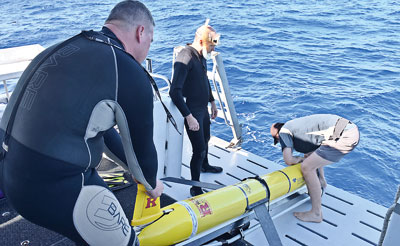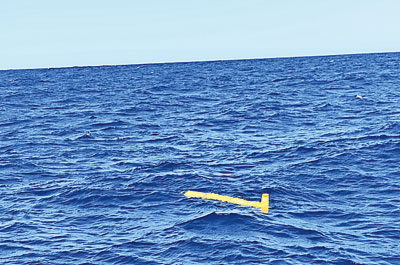Sunday Times 2
Lankan professor’s ocean glider maps the mysteries of Indian Ocean
View(s):By Kumudini Hettiarachchi
Slowly and silently without making ripples, an unmanned mini-submarine is gliding towards Galle, having set off from the western Australian port of Fremantle, looking for the deepest and darkest of secrets buried within the Indian Ocean. Named after something which has gone before, ‘Challenger’, the ocean glider, tracked through satellites will ‘sail’ hundreds of kilometres from the coast at depths of up to 1,000 metres in the ocean.
Travelling a distance of 6,200km, the journey of the seven-foot ‘Challenger’ is expected to be the longest attempted so far by an unmanned ocean glider. As it zig-zags in saw-tooth style over the next 12 months, the researchers who have deployed ‘Challenger’ are hoping to gather data on the impact of climate change on the Indian Ocean.
And linked not only to ‘Challenger’ but also to the search of the ill-fated Malaysian Airlines Flight MH 370 in 2014 is a Sri Lankan.

The path of Challenger's Indian-Ocean leg:
Old Royalist Prof. Charitha Pattiaratchi is leader of the Australian National Facility for Ocean Gliders and Professor of Coastal Oceanography at the Oceans Institute of the University of Western Australia. He and his team have joined forces with Prof. Scott Glenn from Rutgers University and his team to deploy the electric glider and await its recovery from Galle once its mission is concluded.
We caught up with Prof. Pattiaratchi on Friday, while he is on a five-day visit to Colombo during which he delivered the keynote address at a Conference on Ocean Forecasting. He has been at the forefront of predicting weather events such as storms and storm surges and also collaborating in the development and transfer of early-warning systems to countries which lack them, in major efforts to save lives.
Chatting to us at the Hilton Residencies coffee shop, Prof. Pattiaratchi ‘tracks’ the ‘Challenger’ on his mobile phone showing us its yellow-line pathway in the ocean and explaining that it is heading west to reach the green dot, its target, and then glide on northwards. “Look, it was caught in a strong current, what we call an eddy, but now it has gone through it and is heading towards the target,” he says, like a father following his baby’s progress. The ‘red’ on the data sent out by the glider signals warm water and the blue, cold water.
He worries too about the “elements of uncertainty” whether ‘Challenger’ will be able to complete its mission successfully. Like ‘messages in bottles’ washed up on distant shores, the glider has tubes encasing the flags of Sri Lanka, Australia, the Unites States of America and Indonesia and also Letters of Support from these countries.
In the ‘Challenger’ deployment, the collaborators in Sri Lanka are the Indian Ocean Rim Association (IORA) Centre of Excellence on Ocean Sciences and Environment located within the Institute of Policy Studies and the National Aquatic Resources Research and Development Agency (NARA).
Sri Lanka as the end-point of the journey of ‘Challenger’ had been proposed by Prof. Pattiaratchi, as it is also the most logical location to circumnavigate the Indian Ocean.
Delving deep into a subject that many are unfamiliar with, Prof. Pattiaratchi tells the Sunday Times that ocean gliders have been used for about 15 years mainly in coastal waters. He himself has deployed these gliders around Australia over the past 10 years, completing about 250 successful deployments.
“Typically, these gliders last about 1-2 months due to battery capacity, but with developments in batteries and low power systems we can extend the length of deployment,” he says, adding that although ocean gliders have undertaken Atlantic crossings, Challenger’s Fremantle-Galle foray will be the longest.
This autonomous underwater vehicle has a forward speed of 25 to 35 km per day and is propelled by a buoyancy change and steered by means of a tail-fin rudder. Its primary vehicle navigation system uses an on-board GPS receiver, coupled with a depth sensor and an altimeter, to provide dead-reckoned navigation.
The plan is for a change of batteries after the stop in Sri Lanka and re-deployment of ‘Challenger’ to South Africa (Reunion Island close to Madagascar) and then back to Australia, circumnavigating the Indian Ocean over a three-year period.
Details on what information the researchers are hoping to gather from the mysteries enfolded by the Indian Ocean are revealed by Prof. Pattiaratchi who “talks” to ‘Challenger’ through satellite. “As the glider surfaces, it sends us its position and the data — vertical profile of temperature and salinity. We ‘talk’ to it twice a day. The glider moves very slowly and as we need to conserve power it has no camera on board,” he says, laughingly adding that ‘Challenger’ is not expected to encounter strange sea creatures, although the gliders they have deployed in the coastal waters in Australia are frequently attacked by sharks.

'Challenger' being deployed from Fremantle, Australia. Inset: On its way to Sri Lanka
Iridium Communications Inc., through its global satellite circuit switched data service, provides primary two-way communications. The main aims of the mission, the Sunday Times learns, are to better predict the ocean weather – the data from these gliders are input to ocean models, while also highlighting the science through the use of technology. This helps to improve storm-intensity forecasts.
The unprecedented undersea dataset that ‘Challenger’ is due to capture and communicate will help rivet the world’s attention on the ability to predict the ocean’s future, according to this Oceanographer, while increasing global ocean literacy. It will also help them to be part of the global research community attempting to understand and grasp the ocean’s role in regulating the changing climate and weather.

Pix by Prof. Charitha Pattiaratchi
Giving the backdrop to the ‘Challenger’ mission, Prof. Pattiaratchi says that it “re-imagines” the four-year voyage of its namesake HMS Challenger in 1872. The significant scientific question it attempted to answer then was: ‘Could Charles Darwin’s Theory of Evolution be tested by sampling the deep sea?’ The pioneers who made up that scientific and naval team travelled nearly 70,000 nautical miles (128,000 kms) around the globe and used the latest technologies to painstakingly profile the ocean depths and telegraph an expectant world about their discoveries. In the process, they discovered more than 4,000 marine species, it is learnt.
When asked whether the ‘Challenger’ may be tossed around stormy seas or face dangers from collisions with other vessels, Prof. Pattiaratchi hopes that “everything goes OK”.
It is in deep water and will not crash into land or the seabed. It is only at the surface for a very short time and would be very unlucky to hit any surface vessels. Getting caught in fishing nets is a possibility but the biggest challenge is to keep technical faults at bay, he says, reiterating that running a glider for up to 12 months is a big challenge.
Since its deployment on Friday, November 4, the researchers are just starting to compare the data and according to this Oceanographer they will have data that can be compared and contrasted with those collected 50 years ago.
| On the trail of the missing Malaysian plane The world went into shock when Malaysia Airlines Flight 370 with 239 passengers and crew on board which left Kuala Lumpur headed for Beijing vanished without trace on March 8, 2014. Having done computer simulations of the possible debris from the missing plane, it was Prof. Charitha Pattiaratchi who successfully predicted the discovery of the plane’s flaperon in Reunion Island, close to Madagascar.“I seem to get caught accidentally in high-profile news events much to the chagrin of my wife, Gabi, and daughter, Tesni,” he says, adding how the phone rang at 5 a.m. about the missing plane and by 5 p.m. he had given more than 100 interviews to the media. Subsequently, working with American lawyer Blaine Gibson, Prof. Pattiaratchi has predicted where debris would be found like in Mozambique and Madagascar and Gibson has tracked them down.Usually, Madagascar would block most debris travelling from the east, according to Prof. Pattiaratchi. If, however, debris misses Madagascar, it could get washed ashore in Mozambique. | |
| The man behind ‘Challenger’ Swimming and science were his forte from the time he was a boy, though he also took up many other sports, and thus oceanography came naturally to him. Representing Sri Lanka in swimming, he has held many Sri Lankan and national records – one national record remaining unbroken for 18 years. He says that as a sportsman he is very interested in sport, both as a participant and a spectator. “I played competitive water-polo for 35 years, was a soccer coach for 12 years. I have now taken up swimming again and in March this year participated in a swim race from the mainland (Australia) to an island that is 20 km away. This was in a relay team of six and I swam about 6 km.” His interest in science, Prof. Pattiaratchi traces back to his father being a geologist who was the Director of the Geological Survey Department.  Prof. Charitha Pattiaratchi. Pic by Indika Handuwala Numerous are the achievements of Prof. Pattiaratchi, who is recognised as one of the world’s “leading” coastal physical oceanographers whose research encompasses coastal physical processes and their influence on biological, geological, climate processes on the continental shelf region, the nearshore (beach) zone and estuaries. In fact, he was in Payagala, driving down to Bentota with his son, Nafyn, for water-sports when the tsunami struck. “I knew it was a tsunami,” says Prof. Pattiaratchi, recalling how they could not cross Payagala as orus (fishing boats) had been flung across the Galle Road by the tsunami, near the Railway Station which incidentally his maternal grandfather had built as he was from that area. Knowing that a tsunami would generate many waves, father and son had asked the shocked people standing around and they had assured that several waves had come. Reassured, they had headed back to Colombo, but stopped at Kalutara, thinking the worst was over, only to see another monstrous wave assailing the area. Having been summoned to Temple Trees in Colombo to discuss the intricacies of tsunamis which most Sri Lankans had not even heard of, he had arrived there in his beachwear of skinny T-shirt, shorts and slippers much to the consternation of his mother. But by that time the then Prime Minister, Mahinda Rajapaksa, had left on an inspection tour of the ravaged coastline and the meeting fixed for the evening, allowing Prof. Pattiaratchi to be more suitable attired. Suddenly ascending to the status of a TV star, he had been much sought-after both by local and international media, while he has also contributed much to the land of his birth, including the installation of the early-tsunami warning system.A defining feature of his work is said to be the combination of field measurements and numerical modelling, which has led to the discovery and understanding of coastal physical processes leading to unique practical solutions to local environmental problems. |

